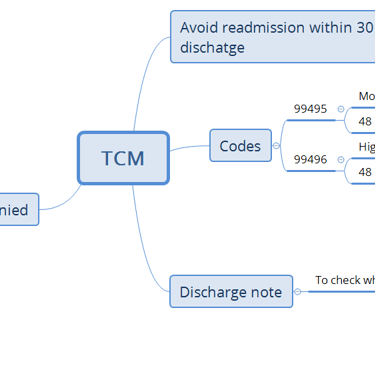Transition care management


Transitional Care Management (TCM) plays a crucial role in ensuring patients have a successful transition from an inpatient setting to their home, ultimately aiming to prevent readmission. TCM services are designed to manage the patient's care during the first 30 days following discharge. This article provides an overview of TCM, including how it works, patient discharge settings, who can provide TCM services, segments of TCM, and relevant TCM codes.
How Does TCM Work?
TCM is focused on managing the patient's care during the critical period immediately following discharge. The primary goal is to ensure a smooth transition to home and prevent complications that could lead to readmission. This involves coordinating care, communicating with the patient and other healthcare providers, and addressing any issues that may arise during this transitional period.
Who Can Provide TCM Services?
TCM services can be provided by:
Primary care physicians
Specialists
Non-physician practitioners (NPs, CNSs, CRNAs, etc.)
TCM services can be provided to patients discharged from various settings, including:
Inpatient acute care hospitals
Inpatient psychiatric hospitals
Long-term care hospitals
Nursing homes
Inpatient rehabilitation centers
Hospital outpatient observation or partial hospitalization programs
TCM services are divided into three main segments:
Interactive Contacts: Within two business days following discharge, two attempts must be made to contact the patient. These contacts can be made by clinical staff and can be conducted via telephone, telehealth, email, or in-person communication.
Non-Face-to-Face Services: These services can be provided by a clinical staff member or the provider team. The specific services provided may vary depending on who is delivering them.
Office Visit: This visit must be performed by the physician responsible for TCM and must be a face-to-face encounter with the patient. The timing of this visit depends on the complexity of the decision-making:
For moderate complexity, the visit must occur within 14 calendar days after discharge.
For high complexity, the visit must occur within 7 calendar days after discharge.
TCM Codes
The following are the two main TCM codes:
99495:
For moderate complexity of decision-making.
Requires reaching out to the patient within 48 hours after discharge (non-face-to-face interaction).
Requires an office visit with the patient within 14 days after discharge
.
99496:
For high complexity of decision-making.
Requires reaching out to the patient within 48 hours after discharge (non-face-to-face interaction).
Requires an office visit with the patient within 7 days after discharge.
It's important to note that there is no specific code for low complexity of decision-making in TCM
